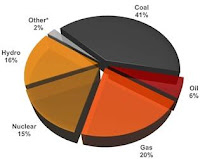It may seem counter-intuitive to bother with the floor at all. A normal rule of thumb is that only about 10% of heat loss from a home is through the floor, with the walls taking about 50% and the roof 40%. This would make it seem that insulating the floor is barely worthwhile. However, most of the effect of the extra insulation which we've installed over the last few years has been felt upstairs. We don't need our bedrooms to be so warm as the living room, but for the last two winters we have found that when we go downstairs on a cold morning, we go from relatively warm rooms upstairs to a relatively cold room when we get to the living / dining room. The conclusion to draw is obvious: while effective, our insulation efforts thus far have been a bit unbalanced, favouring the upstairs, and we now need more effective insulation of our ground floor.
As luck would have it, as we started to think seriously of installing floor insulation a leaflet came through our door which said that the local council would pay for energy advice and an energy performance report for our home (we had these in the UK as well and I'll write more about this later). A few days later Wietse Hiemstra, a very helpful friendly adviser from Real Advies, came to our home and made calculations about all the potential energy losses from our home. These confirmed that by far the greatest potential energy loss from our downstairs rooms was now through the floor. This is so because not only was it not insulated at all, apart from the effect of the carpet, but also because the floor exposes a greater area to the outside cold than anything else on the ground floor
We have a concrete floor with "kruipruimte" underneath. This is a space about 60 cm high through which you can crawl. It's not a cellar. The three options available to insulate this space were to have an 8 cm layer of polyurethane insulation sprayed upwards onto the bottom of the floor, a vast quantity of polystyrene packing pellets poured in to make a 30 cm deep pool at the bottom of the cavity, or pockets of reflective silvered plastic foil could be suspended underneath the floor ("space blanket" material) to reflect heat back into the house.
Initially, I was least enthusiastic about the polyurethane. This was not due to any concern about its effectiveness as polyurethane foam is clearly a very effective form of insulation, but that I didn't much like the idea of the house being made smelly for a long period of time due to the chemical reaction. However, when we considered all the pros and cons, this eventually came to the top of the list.
The silvered plastic foil seemed attractive in that it has the reported lowest cost to the environment. However, while the manufacturer is very enthusiastic about it, I couldn't find any independent verification of its efficacy. I also wasn't sure that I entirely trusted it to stay attached to the bottom of our floor. If we were to look under the house in a couple of years time and see that it had fallen to the bottom of the kruipruimte, then our expensive insulation would have effectively completely disappeared. Perhaps this never happens. However, I couldn't find independent verification. This was also the most expensive of the three options, and therefore would take the longest to pay back in reduced heating costs.
The plastic pellets were the cheapest option. However, this sounded like it would be a real bundle of laughs if there was ever plumbing work needed underneath the house. Our water supply and drainage both run down there. Therefore I rejected this on these grounds.
That left the polyurethane. This would also stick around pipes and wires, but to do work you'd just have to cut away the part of the insulation which was awkward. That left the problem of smells. The suppliers assured us that the smell goes after a couple of days. We decided to take the risk and the work was done on Saturday.
 |
| Installers from Van Den Berg Isolatie. There are four pipes, two supply the two part PU insulation, one provides air for expanding the insulation and the last provides air to breath. |
 |
| Into the kruipruimte. |
 |
| Spraying in progress. The washed out look of the photo is due to the acrid fumes which filled the underfloor space while this went on. An air supply for the guy doing the job was clearly essential. |
 |
| Before |
 |
| After |
 |
| Before |
 |
| After |
Now we wait and see if this makes a noticeable difference to our heating bill over winter.




























